
Mikaela Clark Gardner
Fourth year, Art Education Specialization
Culture Jamming: Responding to Hegemonic Images Through Appropriation
LESSON PLAN
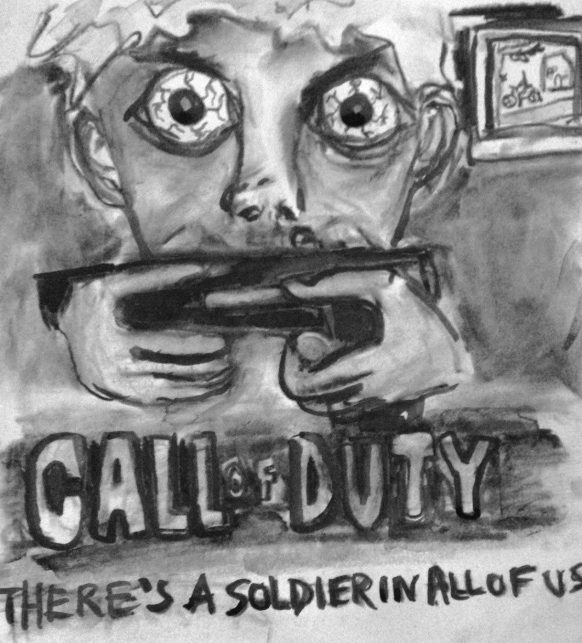

This lesson plan focuses on the art of détournement or culture jamming through understanding and practicing the ethics, strategies, creative process and action-based dissemination. Culture jamming is a social justice oriented methodology that plays with humour, wordplay and wit through appropriating normalized oppressive, hegemonic media or corporate images to reveal their truth. Culture jamming can be used in schools “to promote civic engagement with images, society, and identities” (Sandlin & Milam, 2008, p.326). Culture jamming is relevant to high school students in many ways. Visual culture is closely connected to students’ everyday lives, thus their knowledge will be central and useful within this project to show what is urgent, trending or popular. In addition, adolescents often seek to investigate crossing boundaries and pushing the limits. This lesson acknowledges and supports pushing boundaries as a strength to critically question injustices within our society and to take creative action to dismantle oppressive images. The classroom is also a safe space to explore the effects and ethics of crossing boundaries. In the lesson, we will discuss and practice the theory, “Ethical Spectacle,” within our culture jamming. This theory originated from Duncombe and Boyd’s work, where Duncombe (2014) states “spectacular interventions have the potential to be both ethical and emancipatory.” (p.230).
As a teacher, I will be facilitating the project through providing resources and guidance, but it is important that the project is a democratic process of student-teacher decision-making. This is to foster a creative environment of agency and ownership for all involved. Dewhurst expresses the importance for students to be part of decision-making and “leave room for learners to identify and define their own artmaking.” (p.10). Although I will outline the available materials and amount of class time for the project, our decision-making process will happen during class and group discussion. This provides time and different spaces for inclusive dialogue for students’ to express thoughts, questions and ideas for their project. As the teacher, I will respond with activities, guiding visual prompts, guiding questions for groups and resources to help deepen their learning experience.
Overall, this project aims to help students deepen their understanding and knowledge of systemic oppressive structures, to develop critical thinking, to creatively reinvent images, to gain experience taking action on issues important to them and to have ownership over their own learning.
Population/Timeline
The length of sessions are one hour each with a total of 6 classes.
This lesson is for high school students in their last year. The students need to be familiar with various art materials, visual and media literacy terminology, and research methods. This lesson will be introducing new concepts beyond the art classroom basics. The maximum class size is 30 students.
Objectives
Art materials & Equipment
There is flexibility for art materials, depending on the students’ chosen theme for culture jamming. The art materials that will be available are:
Culture Jamming Concepts and Definitions:
Appropriation: intentional borrowing, copying, and alteration of preexisting images and objects (MoMA, n.d.)
Culture Jamming/Détournement: “Appropriates and alters an existing media artifact…in order to give it a new, subversive meaning” (Malitz, 2014, p.28)
Ethical Spectacle: “offers a way of thinking about the tactical and strategic use of signs, symbols, myths, and fantasies to advance progressive, democratic goals” without crossing ethical boundaries (Duncombe, 2014, p.230). Duncombe identifies five ways that Ethical Spectacle strives to be: “
Participatory: Seeking to empower participants;
Open: Responsive and adaptive to shifting concepts;
Transparent: Engaging the imagination of the [viewer]…without seeking to trick or deceive;
Realistic: Using fantasy to illuminate and dramatize real-world power dynamics…that otherwise tend to remain hidden in plain sight;
Utopian: Celebrating the impossible —and therefore helping make the impossible possible.” (p.230)
Floating signifier: “a symbol or concept loose enough to mean many things to many people, yet specific enough [towards]… action in a particular direction” (Smucker, Boyd & Mitchell, 2014, p.234).
Hegemony: “leadership or dominance, especially by one state or social group over others.” (Oxford dictionary, n.d.)
Subliminal messaging: an underlying message through image and text to subconsciously influence the viewer
Subvert: “undermine the power and authority of an established system or institution” (Oxford dictionary, n.d.)
Transitional spaces: An in-between space, an interruption where “the viewer-learner begins to (re)consider her/his role in society, both as an individual and in relation to others” (Sandlin & Milam, 2008, p.342)
Motivation
Interactive Prezi showing images and videos of artist/activist groups (e.g., Adbusters, Banksy, Guerrilla Girls and The Yes Men). Examples of visuals at the end of document.
Art Media Exploration
Before students start their research process, there will be a ‘warm-up’ art-making activity called, Collaborative Self Jam. The class will get into circles of roughly ten people. Each person will have a sheet of paper and a marker/coloured pencil. Students will have 15 seconds to draw their face, then pass their sheet to the next person. On top of the other person’s face, they will draw their own face in 30 seconds. Again, they pass it. This time they are looking at a sheet with two different faces overlapping and they need to try and connect these faces together. This activity continues with other add-ons, such as, drawing a tongue, a third eye, a cat beside them and so on. Let the class make suggestions. The point of the activity is to see the humour in art-making, to make odd or juxtaposing connections and to get ideas flowing about what appropriation means. In the end, each sheet of paper will have everyone’s work in some way and will often come out as a hilarious image.
Students will be encouraged to experiment with altering and twisting images in different ways during their brainstorming and sketching stage before settling on design/concept. Students are responsible for choosing and exploring art materials available in the classroom. The teacher prototype, along with images of the process, will be a visual and tactile example of some of the possibilities to explore.
Art-making Structure
During the research process and art-making, students will be given time to get into groups of three or four to discuss their findings and ideas. The group discussions will take place during research/sketching/brainstorming, during art-making and dissemination process and a whole class reflection at the end. This facilitates a supportive, collaborative environment to give opportunity to discuss and share ideas or to help overcome challenges. Students can work individually or in groups of 2-3 for their project, although this can be negotiated depending on the context of group dynamics. The classroom environment will be make as open as possible for students freely to move around, work individually, have space to collaborate and get into groups.
Guiding Questions during Group Discussion
1. Why did you choose your theme? Why is this social justice issue important to you?
2. Look at examples of hegemonic images that relate to your theme. Why do you think are they promoting these oppressive messages? What visual and text tools are they using to convey their message? How can you learn from their tools to your advantage in revealing their truth?
3. What images and/or symbols are related to your theme? What materials would highlight your theme and subversive message?
4. Who is your target audience? How are you going to draw their attention? What do you want them to walk away with?
5. Think ahead. How are you going to display your artwork to the public? What materials will be bold for viewers to see from a distance? What materials or art techniques will show the best if your work is being photocopied in black and white? What size are you working with?
Project Time-line
Day One:
Educator Prototypes
During my sketching process, I played with posture, emotions and symbols. I wanted the boy to look tired, focused and consumed by his video game. I first drew a controller in his hands, but then changed it to a gun, to show the reality of what he is doing in this hyper-realistic video game. The controller-gun is covering his mouth to symbol his passivity and obedience to the game.
The video game, “Call of Duty” advertises the slogan: “There’s a soldier in all of us.” In reality, he is a young boy, staying inside, whose mind is occupied by a black-and-white, violent imaginary world. There is a window in the background of the image, showing a bright sunny day that he is missing out on.
The second image I drew takes the “Call of Duty” slogan to a global level. The image is a reminder that war is first and foremost a legitimate horror and not a source of pleasure or entertainment. The international charity War Child estimates that there are 250, 000 child soldiers in the world today, who are often forced to kill their own families before they are taken away (War Child, 2014). Our culture of violence has become normalized through advertising, movies, video games, music, etc. This image attempts to put war in its real context.
Day Two:
Day Three:
Day Four:
Day Five:
Day Six:
Dissemination
The action-based dissemination is vital in getting the learning environment outside the classroom and into the real world. Throughout the project, the class will discuss the ethics, safety and laws regarding culture jamming and display within public areas. Students need to reflect on logistics with location, the materials needed, durability/protection measures for artworks, the size and legal aspects. On day four, there will be a specific discussion on the rules regarding postering in the city or defacing property. *Students need to talk with educator about their ideas of public locations before they proceed.*
Closure
Day six will be the final reflection for the project. As a class, each group will discuss their journey in research, art-making and dissemination.
Reflection Questions: What did you enjoy about the project? What challenges did you face? How did you problem-solve to overcome the challenges? Looking back, would you have done something differently? Would you have liked the project to focus on another direction? What influenced and motivated your art piece? How did you consider Ethical Spectacle within your work?
Final notes: The allotted time frames for each day are suggestive. Students may take a shorter or longer period of time to complete certain parts of the project. Throughout the six classes, the educator will be available for helping with research, asking questions to get students to think critically about their process, sitting in on group discussions, and helping students navigate the art-making and dissemination processes.
Works Cited:
CBS Corporation (Producer). (2011, February 26). “Banksy” creates street art and mystery [Video file]. Retrieved from https://www.youtube.com/watch?v=VDaYqK19q4k
Child soldiers. (2014). Retrieved April 03, 2016, from https://www.warchild.org.uk/issues/child-soldiers
Culture Jammed. (n.d.). Retrieved April 02, 2016, from http://culturejammed.tumblr.com/
Dewhurst, M. (2010). An Inevitable Question: Exploring the Defining Features of Social Justice Art Education. Art Education, 63(5), 6-13.
Duncombe, S., Smucker, J., Mitchell, D., & Boyd, A. (2014). Beautiful Trouble: A toolbox for
revolution (A. Boyd & D. O. Mitchell, Eds.). Toronto: Between the Lines.
Frankenstein, M. (2010). Studying Culture Jamming to Inspire Student Activism. Radical Teacher, 89, 30-46.
Guerrilla Girls: Poster Index. (n.d.). Retrieved April 02, 2016, from
http://www.guerrillagirls.com/posters/index.shtml
Hegemony [Def. 1]. (n.d.). In Oxford Dictionaries. Retrieved April 02, 2016, from http://www.oxforddictionaries.com/definition/english/hegemony
Lambert, S. (Director). (2010, August 10). Light Criticism [Video file]. Retrieved from https:// vimeo.com/14050409
MoMA Learning. (n.d.). Retrieved April 02, 2016, from https://www.moma.org/learn/ moma_learning/themes/pop-art/appropriation

Jean- Marc Duchesne
First Year, Art Education Major
We Are Here
Writing and Photography
2017
Unless you are constantly absorbed by the screen of your mobile device, you cannot ignore the many homeless men sharing the streets of Concordia’s downtown campus. Staring blankly, sitting, or lying on the hard, cold ground, they are fathers, uncles, a brother. They ask for coins, a hot coffee, but mostly they are looking for conversation. If you don’t believe me, next time, just say, Hi. Introduce yourself, and ask their name. You’ll never believe how much it is appreciated: the mere act of acknowledging their presence in the neighbourhood goes a long way towards making them feel visible, and human. It’s worth infinitely more than any loose change you’ll throw their way.
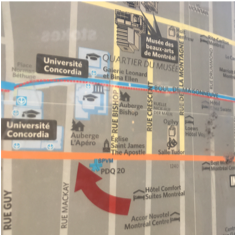
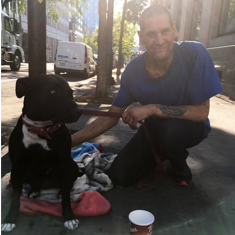
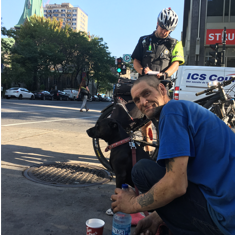
Every Image, Every Person a Story
9:15 am, Monday morning, Art Education assignment: Imagine you are suddenly without sight. What final visual image would you leave to the world as your legacy? Create a photo and present it to the rest of the class in 60 minutes! This exercise came from our teacher, Bettina Forget, a visual artist and a Ph.D. student in the department. As a documentary filmmaker, I didn’t want to make just an aesthetically pleasing photograph. I wanted a story to emerge.
9 :30 am, I start :
Snapping stills and absorbing the outdoor city space.
Natural light, sound, form. People appear in peripheral view.
Instinctively, meditatively, a trance, a dance.
Strut, stop, frame it with the mind’s eye.
Passersby, reflections.
Paint peel, brick, orange cone, no detour.
Form, function, colour, pattern and shade guides the frame.
Now, I am here.
Look there.
A guy, sitting on the sidewalk, his dog I figure.
A Tim’s cup, a couple of coins inside— the frame is now revealing the story:
“May I take a photo of the coins in your cup?”
“Certainly,” the guy replies. I snap two.
“Why are you taking a photo of my cup”?
“For an art project,” I reply.
And there begins the conversation.
Dave’s his name. Next to him, his dog, Diamond.
Five years they’ve been homeless.
Shelters offer refuge but get there early, he says, or there are no more beds!
Food ? He knows when and where he can get a free meal.
Worked before, minimum wage, no more.
Diamond needed a hip surgery and that’s costly, but Diamond’s worth it.
This is only temporary. “Well, it has been 5 years,” he says, realizing temporary is a relative time frame.
Then two police arrive on bikes, stop our tête-à-tête. “Hi Dave, you know you can’t be here,” says the bike cope and proceeds to write out an infraction ticket.
I address the officer, “Why are you writing Dave a violation fine?” I felt I needed to ask, and hoped he might change his course of action.“It’s the law, and I’m doing my job,” he says. I’m outraged but decide to remain stoic and to let a photo speak my mind. Turning to Dave, I ask,“Do you mind if I snap a photo and make you and Diamond part of my art work?”
“Go ahead man,” responds Dave.
A few clicks at different angles. Leaving I say, “Thanks Dave,” my hand gesturing towards my heart.
Dave yells out as I turn to walk away : “Keep doing your art, Marc…
and come say Hi again.”
Story & Images by Jean-Marc Duchesne. JM is currently pursuing his BFA, Art Education, at Concordia University. As a documentary filmmaker, he has journeyed with his cameras on multiple assignments to many hostile and underdeveloped locations. His only brother lives a homeless existence.
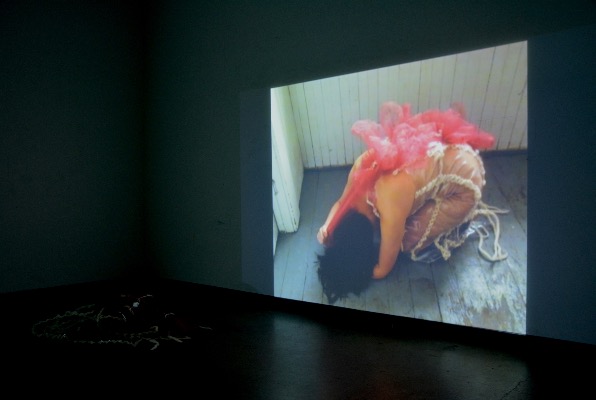
Élisabeth Harvey
Third year, Art Education Specialization
Keeping it Together
Nylon tulle dyed with Lac, vinyl, wool yarn
2:03 min Video projection of performance
2017
Weighted
2:36 min Video Montage
2017
Keeping it Together
The video performance, Keeping it Together, explores the body’s surface as a container, a barrier and a mediator of experience. This artwork sprung from an inquiry about the body’s ability to produce and interact. The vinyl embodies the invisible border that our skin imposes on our experiences. In this performance, the body reaches out, grows, evolves by moving from outside its boundaries to inside its container. The containment by the body is rendered by the use of a diaphanous red fibre material being place under and through the vinyl skin.
Weighted
The video, Weighted, explores the body’s weight and its capacity to fill and occupy a space. I created this project as an experimentation to understand the potential of video montage and sound sampling. Transparency occupies an important place in layering multiple bodies to break down movement and fill the screen. The colours create a visual rhythm, but also boundaries, highlighting various lines present both in the space and in the body. The entire video was shot in a bedroom, and some of the upside down image alterations are used to suggest ideas of personal inner space and weightlessness for the body movement.
Please visit the link to view both performances: http://www.elisabethcharland.com/video-performance.
Élisabeth Harvey
Third year, Art Education Specialization
Integrating a Negotiated Curriculum Approach
Written Work
As a student-teacher, the exploration of various educational theories is crucial to the creation of a teaching philosophy. What sticks to your teaching practice is highly informed by what you come in contact with as a student-teacher. While on such an exploration, I came across an article “Negotiating to Engagement: Creating an Art Curriculum with Eight-Graders,” by Alice C. Pennisi (2013). Pennisi discusses her research on the re-engagement of a classroom through the use of a negotiated curriculum. A negotiated curriculum is described as the process of creating an art curriculum through negotiation between teacher and students. The teacher expresses the non-negotiable constraints that must be included in the curriculum, but the rest of the content is generated in partnership with the students.
This responsive approach to teaching intrigued me for its potential to promote student’s intrinsic motivation and student agency over their learning. The notion of teacher and students being partners in learning resonated with my aspiration as a student-teacher. A negotiated curriculum generates an idea-centered classroom as opposed to a teacher-centered one. Pennisi (2013) offers guidelines for implementation, such as the necessity for teachers to “make clear any non-negotiables constraints, so teachers and students know their respective responsibilities” (p.129). Other parameters necessary for the success of this approach include the decrease of “teacher talk” and the expansion of the definition of in class work. To decrease teacher talk, Pennisi (2013) suggests using signs with prompts, to encourage student autonomy upon entering the classroom. She also encourages teachers to “not teach,” “meaning [to] not do anything students could possibly do themselves” (p.135). This classroom structure relies on peer experts revealing themselves organically in the group to further support decreased teacher talk. The peer experts share the teacher’s responsibilities of transferring knowledge and support the creation of a community of learners in the classroom. To broaden what we consider as working in the art classroom, Pennisi suggests seeing research, reading and writing as valuable practices for students to engage in during class time.
The advantages of such an educational practice are evident, whether it be the opening up to diverse points of view and/or the increase of student’s engagement and motivation. A negotiated curriculum is anchored in critical theory and offers the possibility to alter power dynamics in the classroom. A shift in power dynamics can be achieved through the interrogation of the curriculum’s content by the partners in learning. Critical reassessment of curriculum favours the inclusion of new and/or historically marginalized knowledge. Although the level of student involvement required for the implementation of a negotiated curriculum might not be suitable for all classrooms and may cater to older learners, it showcases a way to foster student agency over learning that could be adapted to fit various contexts.
Reflecting on my own teaching practice, I wondered how I could integrate the negotiated curriculum educational approach to my classroom. Working with a group of 16 younger students (9-12 years old) in a community setting over the course of 12 weeks meant that I would have to adapt some elements to suit the younger age group, the duration, and the context. I implemented this approach by asking for student input and feedback about their learning and engagement during the first semester of an internship in 2017. This discussion took place as I was about to prepare the projects for the next semester of 2018. Students contributed their opinions on projects and subjects covered and provided suggestions regarding themes, materials, and processes they were interested in trying. I let them know some of the limitations concerning time and resources, and they expressed their satisfaction for my active listening and for being concerned with their interests. This open dialogue about the content of the course seemed to give them a sense of ownership over what was to come. In regards to the classroom structure of this approach, it will be something to ease into as the new semester begins. My hope is to integrate some of the methods for self-directed learning, for example, using signs and peer experts, amongst other tactics, as suggested by this article.
Works Cited:
Pennisi, A. C. (2013). “Negotiating to Engagement: Creating an Art Curriculum with Eighth-Graders.” Studies In Art Education: A Journal Of Issues And Research In Art Education, 54(2), 127-140.
Sylvia Erlichman-Gross
Third year- Art Education Major
It’s Time for Some Creative Changes: Opening Our Eyes to New Perspectives About Individual Art-Making in Quebec Elementary Schools
Written work
I am an undergraduate student working towards my BFA in Art Education at Concordia University in Montreal. During a recent internship at an elementary school, I found that the students lacked enthusiasm for art class and were not engaged in the lessons and assignments; the teacher was more focused on the structure of the class than the morale in the classroom. Creativity cannot be taught, it must be nurtured. Nurturing creativity leads to confident self-expression, which again in turn leads to strong and passionate change-makers in our society. Tying lessons to a specific set of rules squanders the opportunity for one’s creativity and imagination to flourish. This is counterproductive to the future of society.
In contrast to what I saw as an intern, models of education like the Waldorf, for example, let students explore the new material and ideas before the teacher presents the concepts clearly and hands out reading material. This method of teaching can be more rewarding for the students in the art classroom, as they would be able to explore new mediums and techniques, which ignite imagination and independence before learning the theories. I believe that the creative freedoms articulated in the Quebec Education Program under Visual Arts Education¹are constricting and preventing young students in elementary school from expressing themselves fully in the art classroom. The Ministry of Education and Higher Education identifies three competencies in the visual arts for preschool and elementary school arts: To Produce Individual Works in the Visual Arts (Competency 1)², To Produce Media Works in the Visual Arts (Competency 2)³ and To Appreciate Works of Art, Traditional Artistic Objects, Media Images, Personal Productions and Those of Classmates (Competency 3). 4
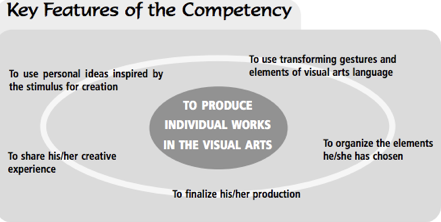
Figure 1: A diagram of the objectives outlined under Competency 1, as shown in ch. 8.2 of the Quebec Education Program for Elementary Education document.
The section Competency 1 (Figure 1): To Produce Individual Works in the Visual Arts 5 outlines the creative process, as well as how students will progress through the Elementary school system. Competency 2 focuses on the students’ abilities to create media images that express their individual understanding of reality or personal experiences using elements of visual arts language that will support their intended message to show to viewers. Competency 3 focuses on art appreciation and building critical thinking skills as well as learning to examine and reflect on experiences as well as media images discussed. Although the Quebec Education Program (QEP) makes very strong arguments in each competency section, in reference to the production of individual works of art, the first competency holds a very rigid structure, which results in conformity instead of encouraging creative thinking.
The current structuring of the creative process in elementary education is at risk of silencing the creative ideas of students both in the classroom, as well as outside the classroom. I believe that focusing on a child-centered approach–including conversations about critical thinking, direct communication from teacher to student one-on-one, and encouraging respectful discussions and presentations in the art class environment–will ultimately provide a supportive space for elementary school students. With this, they will be able to express their ideas themselves by using lessons as time for expressive and free art making as well as structured projects. When lessons that focus on Competency 1 are planned in a way where they introduce information and material at the beginning of the class in a presentation format, this deters students from mentally and physically engaging in the beginning of the lesson. This type of engagement is well defined and opposed in the Waldorf model of education.
I saw this during the observational internship I participated in during my first year in the major program. I was placed with the Art Specialist, and observed both Grade 3 and 5 art classes with an average class size of 22. For both grades, the Art Specialist focused largely on Competency 1, starting each lesson in the same format: A presentation style, where students must sit on the floor in a specific way, listen to the teacher explain new material and review the objectives for that day’s class. Every individual project had specific parameters, and held potential for students to utilize their unique creative ideas for specific aspects of the project. For example, the Grade 3 class was assigned a drawing project where the students would pick their favourite scene from a fairy tale that they were reading in English class and then recreate that scene in a drawing. Students imagined what the scene would look like if the story took place in the future. They were required to include the characters that were involved in that part of the fairy tale as well as any other given details, such as an action or setting that were mentioned in the story. But I found that many students had trouble drawing the characters as well as including everything that the teacher instructed for the lesson, leading to incomplete work for around 60% of students in that class. With what I have personally witnessed, I would argue that this particular project limited students from engaging with the assignment and that those specific rules inhibited the students from completing the project.
As part of my internship, I had the chance to teach one art lesson to a class of my choice–thereby giving me a chance to challenge the methods I oppose. I chose to teach the same Grade 3 class that had repeated difficulty completing the fairy tale project, as well as other projects over the course of the semester. My lesson took a child-centered approach and was based on experiential learning. I invited students to sit at the art-making tables and explained that we would be painting to all different kinds of music. They responded, “That’s all?” After the students played with the wide variety of materials that I had offered them and danced while painting, drawing, gluing and laughing, I facilitated a response activity where students could respond to some questions about their experience. I had overwhelming positive feedback; students were very vocal about what kinds of music they did and did not like as well as their favourite materials to use. Many of the students asked to do this activity again next week! I saw their response to my lesson as a sign that they were craving freedom in that art class. They needed more room to use their imagination, and they responded very well to immediately starting the art-making experience, rather than behaving in a controlled way in the classroom, and during specific projects as well. Creating a balance of both structured and creative lessons that use free art making would help students to express themselves more freely and explore their connections to art in independent projects.
According to the QEP: “Visual arts education, in the context of continuous progress throughout elementary school, helps children acquire visual literacy and develops their creative potential with regard to the visual world and their abilities to symbolize, express and communicate through images.”6 The QEP should not only continue to promote visual literacy in art class but also incorporate experiential learning into the provincial document so that students can reach their full potential and communicate their own individual understandings of reality.
I think teachers must be as frustrated as students with the demands set out by the QEP. I reflected on my notes over the course of the internship and I found the teacher to be focused on the end product, rather than the process. I found that this was when the students started disengaging with the process the most, primarily by talking amongst each other. Instead of continuing with the current outline of Competency 1, I believe other methods should be incorporated in the learning process in elementary school such as that of former elementary school teacher, David Rufo, currently an Instructor in the Art Education Department of Syracuse University in New York. In his article, Allowing Artistic Agency in The Elementary Classroom,7 Rufo draws from qualitative research in the form of journal entries that reflect on observations he made during two specific activities he ran in his classroom, called Read Aloud and Open Studio. Rufo’s research found that “giving up arbitrary control over creativity in the classroom allowed children to have ownership of their own creativity.”8 He writes, “Children need time to create unfettered by systems, institutional expectations, and government-directed assessments. Art does not conveniently fit into, and should not be forced to adhere to, the ways in which other curricula are designed and put into practice.” 9
One reason for the frustration might be the way the Quebec Education Program describes the process of learning in the visual arts. Overly explicit descriptions of how creative thinking progresses in each student can make art educators feel boxed in when creating lessons for their classes. From my perspective, it’s not about the end result but how you get there. Whether exploring new skills and techniques to accomplish a certain pattern in drawing, for example, or learning more about themselves through the process of making an artwork; what students learn in the process of making art is often the most rewarding part of class.
I value the Waldorf model of education for its “child-centered initiatives”10 and for how it recognizes the individual ways in which each child learns; it’s a model that asks students to relate the material they learn to their personal life experiences and to reflect on new information through their individual creative modes of response. A Waldorf teacher for 14 years, Bonnie Chauncey discusses the approach, using science as an example,“the typical approach is for the teacher to explain a concept or phenomenon to be studied, and to then use hands-on activity to illustrate it. Contrast this with a Waldorf science lesson. Here, the concept comes at the end, not the beginning.”11 This approach to teaching in the classroom is exactly what I have described previously. By allowing this creative exploration of either new material, or new art pieces and artists, children are supported in forming their own ways of thinking critically as well as forming their own judgement.
Another supporter of the Waldorf model would be Carrie Nordlund, who is an Associate Professor of Art Education at Kutztown University of Pennsylvania. After teaching art in public schools for 10 years, and a critic of the No Child Left Behind Act in the United States, she started to search for alternative approaches to learning.12 Based on her research, conducted with Waldorf graduates across the country, Nordlund believes that “Waldorf-Inspired practices,”13 “may spur greater mindfulness of creativity within our classrooms or schools.”14 She writes, “When making art, we essentially play: translate and construct our world, create new things, and take risks with the unknown.”15 This statement reflects my view on what needs to be incorporated in the Quebec Education Program for Visual-Arts Education, using Waldorf ideas and structures to enhance and strengthen Competency 1 of the Visual Arts section in Arts Education within Quebec’s Education Program.
Creativity is an innate, inalienable right that can no longer be lost as one matures into adulthood. It is the creative thinkers of the world that have made the huge changes in human society. Creativity cannot be taught as rote behaviour, it must be nurtured and supported, perhaps through non-traditional methods such as the Waldorf model. Enriching the curriculum with child-centered approaches in addition to considering the Waldorf model would create a well-rounded method to teaching art in elementary schools. A critical reassessment of Competency 1 in the Quebec Education Program Visual Arts Education outline will not only help the students, it will be a more satisfying and enriching experience for teachers and students alike.
Endnotes:
[1] Ministry of Education and Higher Education. Québec Education Program: Arts Education – Visual Arts, n.d. c. 8.2. Government of Québec, 2016.
[²] Ibid., 228-229.
[³] Ibid., 230-231.
[4] Ibid., 232-233.
[5] Ministry of Education and Higher Education. Québec Education Program: Arts Education – Visual Arts, n.d. c. 8.2. Government of Québec, 2016, 228-229.
[6] Ministry of Education and Higher Education. Québec Education Program: Arts Education – Visual Arts, n.d. c. 8.2. Government of Québec, 2016, 226.
[7] Rufo, David. Allowing Artistic Agency in the Elementary Classroom (Art Education, 2011), 64 (3):18-23.
[8] Rufo,David. Allowing Artistic Agency in the Elementary Classroom (Art Education, 2011), 64 (3): 22.
[9] Ibid., 23.
[10] Chauncey, Bonnie, The Waldorf Model and Public School Reform (Encounter, 2006) 19 (3): 39.
[11] Ibid., 40.
[12] Nordlund, Carrie, Waldorf Education: Breathing Creativity (Art Education, 2013 66 (2): 13.
[13] Ibid., 16.
[14] Ibid., 15.
[15] Ibid., 15.
Works Cited:
Association of Waldorf Schools of North America. Accessed June 09, 2017. https://waldorfeducation.org/.
Canada. Québec. Ministry of Education and Higher Education. Québec Education
Program: Art Education – Visual Arts, n.d. c. 8.2. Government of Québec, 2016. http://www1.education.gouv.qc.ca/sections/programmeFormation/primaire/pdf/educpr2001bw/educprg2001bw-082.pdf.
Chauncey, Bonnie. 2006. “The Waldorf Model and Public School Reform.” Encounter 19
Department of Art Education & Crafts, Kutztown University of Pennsylvania. Accessed
June 11, 2017. http://www3.kutztown.edu/arteducation/carrie-nordlund.html.
“David Rufo.” Syracuse University – Academia.edu. Accessed June 09, 2017.
http://syr.academia.edu/DavidRufoPhD.
Nordlund, Carrie. 2013. “Waldorf Education: Breathing Creativity.” Art Education 66 (2): 13-19.
http://0search.ebscohost.com.mercury.concordia.ca/login.aspx?direct=true&db=eu
&A=85691456&site=ehost-live&scope=site.
Rufo, David. 2011. “Allowing Artistic Agency in the Elementary Classroom.” Art Education, 64
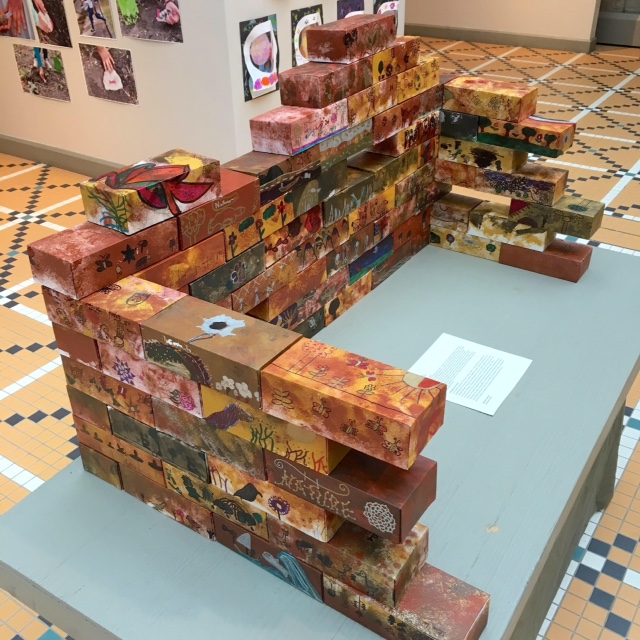
Matthew Thomson
Third year, Art Education Specialization
Messages on the Wall
Lesson Plan
Last year, as Montreal and Canada celebrated milestone birthdays with big events and strong messaging, there was very little consideration of First Nations peoples. I decided to use my teaching practice to celebrate the longstanding and rich histories of Canada’s Indigenous peoples. Pictographs and petroglyphs are some of Turtle Island’s oldest art forms, predating colonization and the development of Montreal and Canada. Pictographs and petroglyphs are pictorial messages created by shamans as a means to connect with the spirit world, while also leaving traces of their culture and beliefs behind, to be discovered in often remote locations. Inspired by this rich artistic and cultural legacy, I worked with 70 students in grade 4 and 5 at École St-Léon-de-Westmount, asking them to consider a longer history of “messages on walls,” to reflect on their own relationship to the land, and to use these as starting points for personal expression and public engagement. Each student used a fold-able paper brick as their canvas, and these were assembled to create a collaborative wall that activates an important conversation between the past and the future, as well as encouraging reconciliation through art-making.
This art activity was one of multiple visual arts contributions to the 2017 McEntyre Project, which was coordinated by the Westmount Visual Arts Centre’s ARTreach program and the Westmount Public Library. During the McEntyre Project, the Visual Arts Centre sends various art educators to different schools in Westmount to engage with the learners, and the results are exhibited in a lovely group exhibition at Victoria Hall. The teachers from the Visual Arts Centre are aided by the art teacher from the hosting school. The theme for the 2017 McEntyre Project was “Secret Places, Hidden Treasures.”
Grade Level:
This 2.5 hour art activity was originally created for elementary school learners in grade 4 and 5 for the 2017 McEntyre Project. It could also be modified so as to be taught to learners from grade 6-grade 9.
Lesson Objective (please see the lesson sequence for more details) :
This art activity introduced the learners at École St-Léon-de-Westmount to the history and significance of pictographs and petroglyphs on the landscape in Canada. I offered learners a provisional definition of the word “shaman” and gave a sense of how and why they created these images. Subsequently, I showed contemporary examples of graffiti in Montreal and asked students to think about how this form of public art can promote a positive message, social justice and equity. Students then identified ways to represent nature and care for the environment, and these ideas were used as a catalyst in the production of the imagery for their bricks. Students were discouraged from mimicking the petroglyphs or the graffiti; rather, they were encouraged to invent their own imagery, based on their lived experience.
Students learned a painting technique that would enable them to create the look of a brick, using acrylic paint that was applied on paper with a sponge. Afterwards, they were encouraged to create and develop their images, using multiple colors of Sharpie markers over the acrylic paint. Once the bricks were finished, they were transported to Victoria Hall and assembled into a wall-like installation for exhibition.
Materials and Resources:
-Bristol board (22” x 30”, 2-ply minimum; 4-ply is ideal for painting and keeping its shape once folded) ; you can get 2 bricks from 1 sheet of Bristol.
-Scissors (can be used by students)
-Exacto knife (to be used by the art educator)
-A Bone Folder
-12” rulers and at least one 24” ruler
-Acrylic paint: Yellow Ochre, Raw Umber and Burnt Sienna
-Sponges
-Paint trays (like reused styrofoam plates from the grocery store)
-HB Pencils and some coloring pencils
-Erasers
-Black Twin Tip Sharpies, a selection of colored Sharpies (regular), Gold and Silver Sharpies and a selection of Sharpie Brush markers
-Glue Guns
-A projector (for showing a slide show prepared by the art educator)
Lesson Sequence/Procedures:
For this project, the bricks were made to the same scale as a regular-sized brick, which is 3-5/8″ x 2-1/4″ x 8.” I designed a template that would be used to measure and cut a paper brick for each student. The template contains a bit of overhang material that is suitable for gluing and needs to be creased using a bone folder. The template is laid upon an edge of a Bristol paper and you use it to trace the outline, in addition to marking the lines where the creases will be made. Although this required some preparatory work, it made for a substantially smoother lesson later on. Once the bricks were prepared, learners could easily produce their work, and then be able to fold and glue it to make their final piece, in a way that they wouldn’t damage it. Whatever leftover paper from the cutting was used for other projects.
I presented a slideshow to students, which took approximately 30 minutes and presented several key aspects of the historical, cultural and artistic material before they embarked on their painting and drawing. I introduced the slideshow by establishing the theme of the McEntyre Project, which was “Secret Places, Hidden Treasures.” We proceeded to look at an example of the Mazinaw Rock pictographs made by Anishinaabe shamans and elders at Bon Echo Provincial Park (that I had photographed while visiting the site in 2014). I also showed other Anishinaabe rock art examples from Agawa Rock (Lake Superior) and Fairy Point (Lake Missinaibi). I explained how pictographs were created by applying red ochre and other pigments to rocks, using the finger or a brush, and how petroglyphs, while similar in imagery, were created by abrading the rock face using stone tools. Students were invited to try to identify the shapes in the images and to speculate as to why First Nations peoples created these.
As a non-Indigenous person, I offered only a preliminary glimpse of the role of the shaman in First Nations cultures and the relationship between the images–which depicted animals, people, mythological creatures and other cultural referents–and the places that they were made in, which were often remote and hard to reach. Seen hundreds of years later, these images are like messages on walls, left for future generations to see and appreciate. Today, they may offer a starting point for young artists in thinking about our relationship to the land and to reconciliation.
Continuing the slideshow, we segued into graffiti and public art murals, so as to establish a contemporary connection to the idea of Messages on the Wall. Graffiti murals are a bold, expressive and highly popular public artform occurring on brick and other types of walls and surfaces around Montreal. The murals, aside from featuring aesthetically pleasing and elaborate imagery, have the ability to convey an important message in a public place about an important issue. I showed examples of murals by Curiot and ASHOP and encouraged learners to think about how these could impart a positive message about respecting and caring for the environment. I asked the students to think about their own experiences of these themes and offered an assortment of visuals that they could use as a source of inspiration if they had trouble coming up with their own imagery, such as line drawings of animals, visuals of landscapes, and symbols of care for the environment or positive engagement with nature. This was another opportunity to discuss the integrity of the art we had looked at, as well as the significance of students coming up with their own imagery. I invited students to make begin making sketches of some of their ideas on paper, as a preparation for later on.
We continued by covering their bricks with acrylic paint, using sponges to apply the medium in order to give it the desired look. There were 6 work tables, and each table had one of the three colors–yellow ochre, raw umber and burnt sienna–on a styrofoam tray. Some students chose one colour, while others played with two or three colours to give their brick a “random” kind of look. The paint was applied in layers, allowing each layer to dry before the next application. Once finished, these were left to dry until the next session.
During the following period, I offered students pencils to quickly sketch out their drawings before they produced finished drawings using the Sharpie markers. For those who were working on a darker colored brick, they were offered a coloring pencil, which made a more visible line than the HB pencil on top of the acrylic. Students had approximately 1 hour to make their drawings. They were invited to use text in their drawings, so as to emphasize the theme. They were encouraged to draw on two of the four panels -what would end up being the front and the back of the brick- because once the bricks were stacked, the viewer would not be able to see all the sides of the work. The art teacher and myself walked around, offering encouragement, tips and ideas for their creations.
Finally, as the students were finishing their work, they were reminded that the bricks would be individually assembled and that all of these would come together as a modular installation to create a wall. The students would be able to experience collaborative nature of the project and the installation, and discuss the art-making process and ideas behind it with their parents and peers once the exhibition at Victoria Hall was open for the public.
After completion, the works were transported to the exhibition hall and assembled using hot glue. Because they were creased beforehand, it was relatively fast to assemble them. We created an installation with the bricks so as to produce a free-standing wall that you could walk around. In this way, you could see the hand-drawn parts on the front and back of each brick, and experience all the works as a whole.
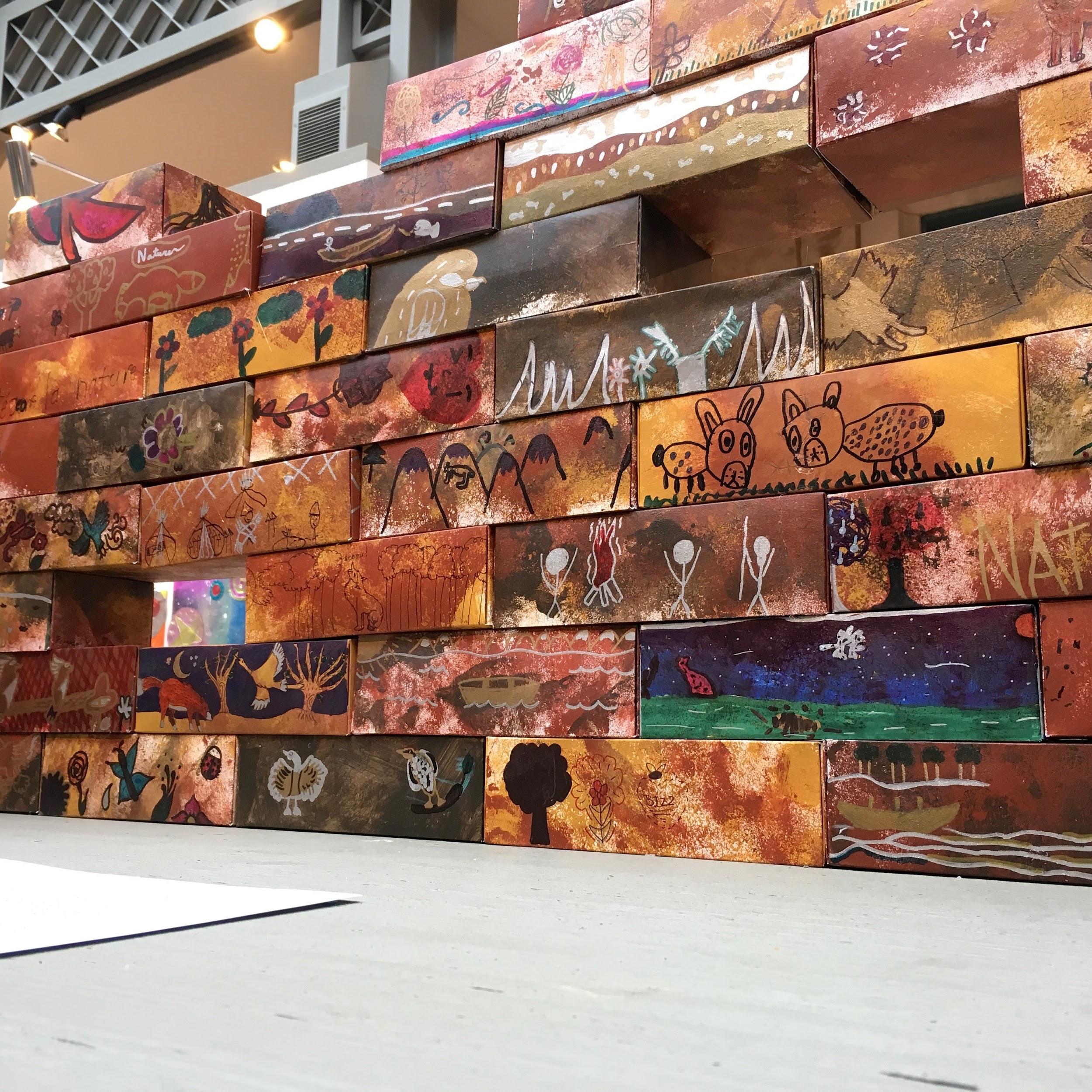
Works Cited:
Rajnovich, G. (1994). Reading rock art: Interpreting the Indian rock paintings of the Canadian Shield. Toronto: Natural Heritage/Natural History.
Pictographs and Petroglyphs. (n.d.) In The Canadian Encyclopedia. Retrieved from
http://www.thecanadianencyclopedia.ca/en/article/pictographs-and-petroglyphs/
True_North. (2013, July 7). Anishinaabe Pictograph Sites In Ontario [Blog article]. Retrieved from https://albinger.me/2013/07/07/anishinaabe-pictograph-sites-in-ontario/
Curiot. (date unknown). (Title Unknown) [Graffiti Mural]. Mexico City. Retrieved from https://www.widewalls.ch/street-update-12/
ASHOP. (date unknown). (Title Unknown) [Graffiti Mural]. Montreal. Retrieved from http://www.ashop.ca/portfolio1/4lx1vdsrrmwvc4xu6tobpgqccjz9k0
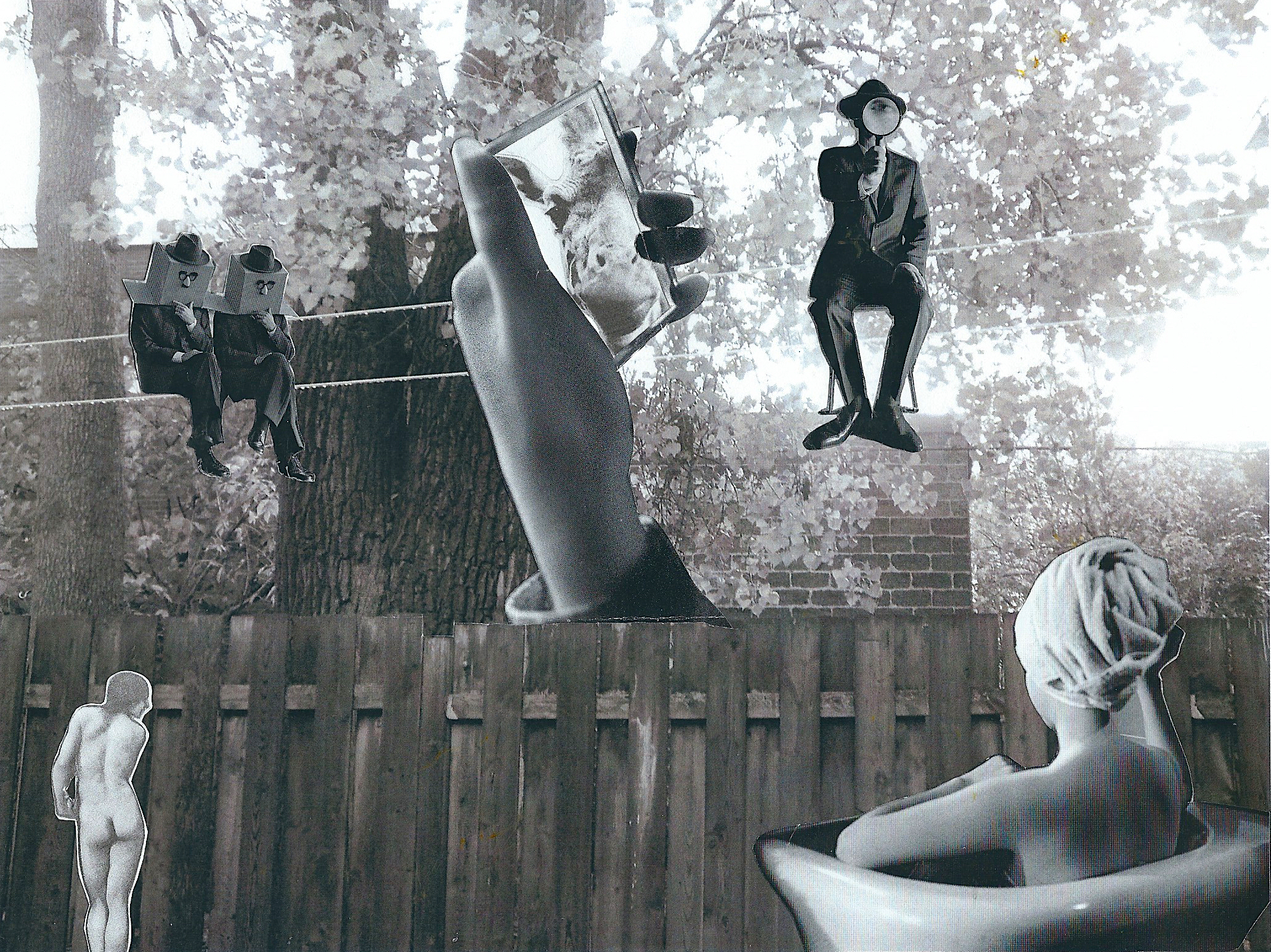
Christine Vista
3rd year, Art Education Major
Over the Fence (series)
Photographs and collage
8.5″ x 11″
2017
Fences are strange, they are butchered trees, stuck back into the ground and made to stand among nature as if they were still alive.
Fences are absurd, they are artificial boundaries, made for the privacy of the people living within their enclosed spaces yet they have gaps wide enough to look into.
Fences are bizarre, they are one of the things we all have in common that divide us. Yet why do we see them as such a necessity, even though they are objects that contradict themselves?
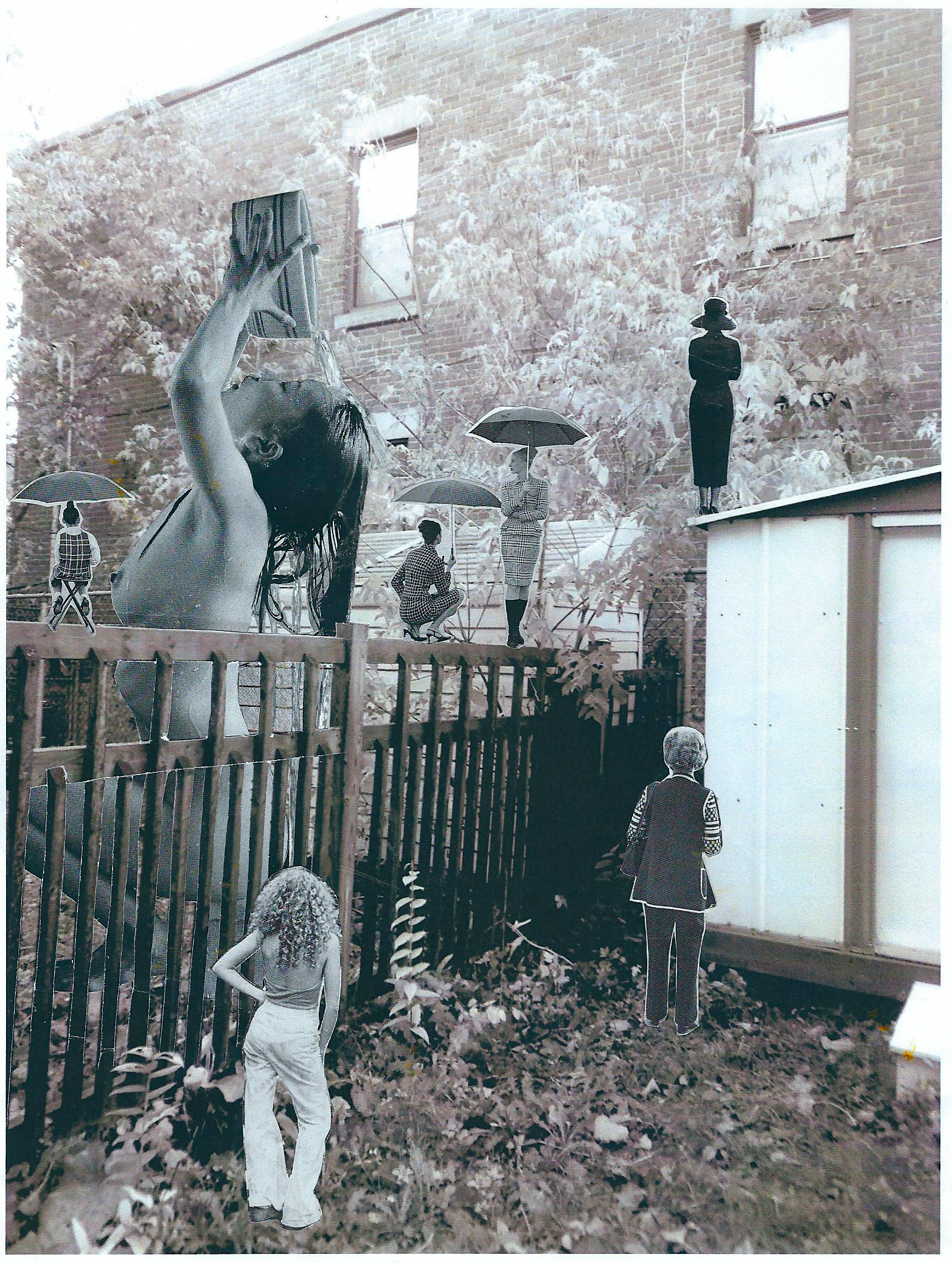
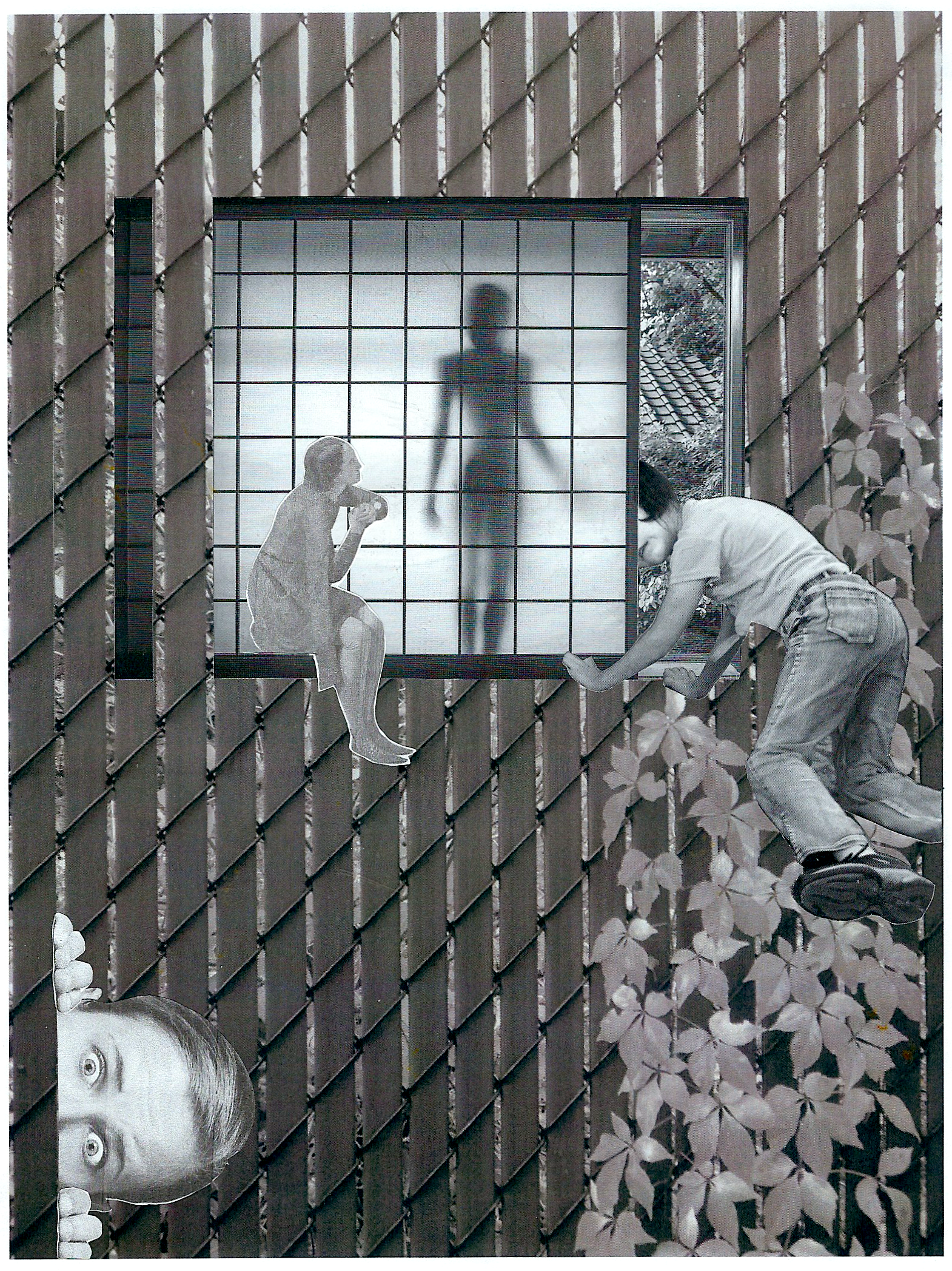
I was in the backyard, finishing an erotic painting for a studio class when I had to retreat back into my house after hearing my neighbour’s door open. I was fearful of their gaze, and the invasion of privacy. After telling my friends this story, I found out that I’m not alone when it comes to awkward experiences with neighbours. Seeing neighbours through their fences is really weird, locking eyes with them, even more. I’m not the only one who looks out the window to make sure their neighbours aren’t there before going outside. Avoiding neighbours is something we might have in common, other than fences.
In this work, the fences around my house become the settings of certain all too familiar narratives, wherein images of bathing or naked women are juxtaposed with “onlookers” to represent something more than the merely ‘awkward.’ Here, viewers transgress the privacy afforded by the fence, raising questions about voyeurism and sexual violence. Using photography and collage, this work presents fences as a metaphor for proximity, secrecy, distance, privacy, and contradiction.

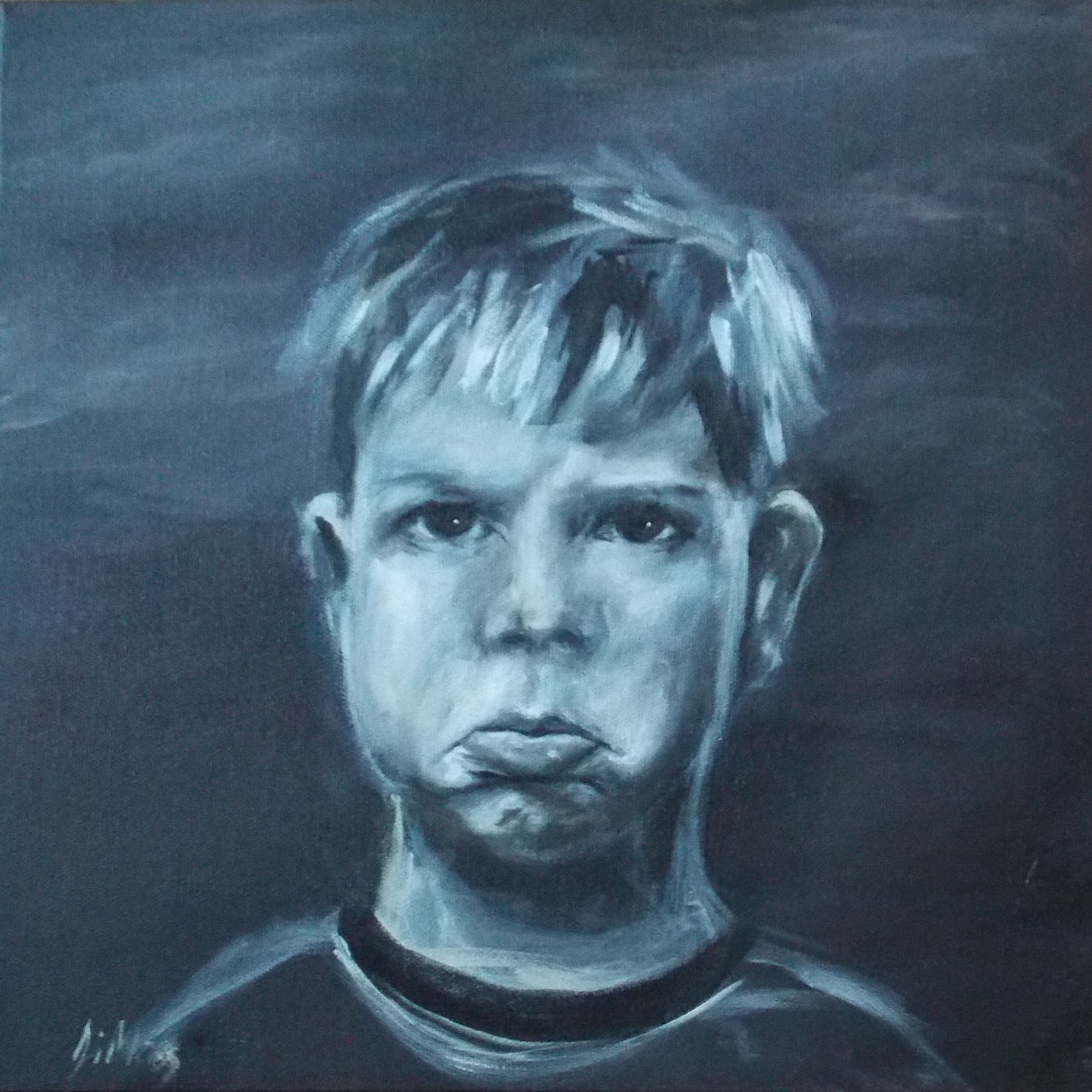
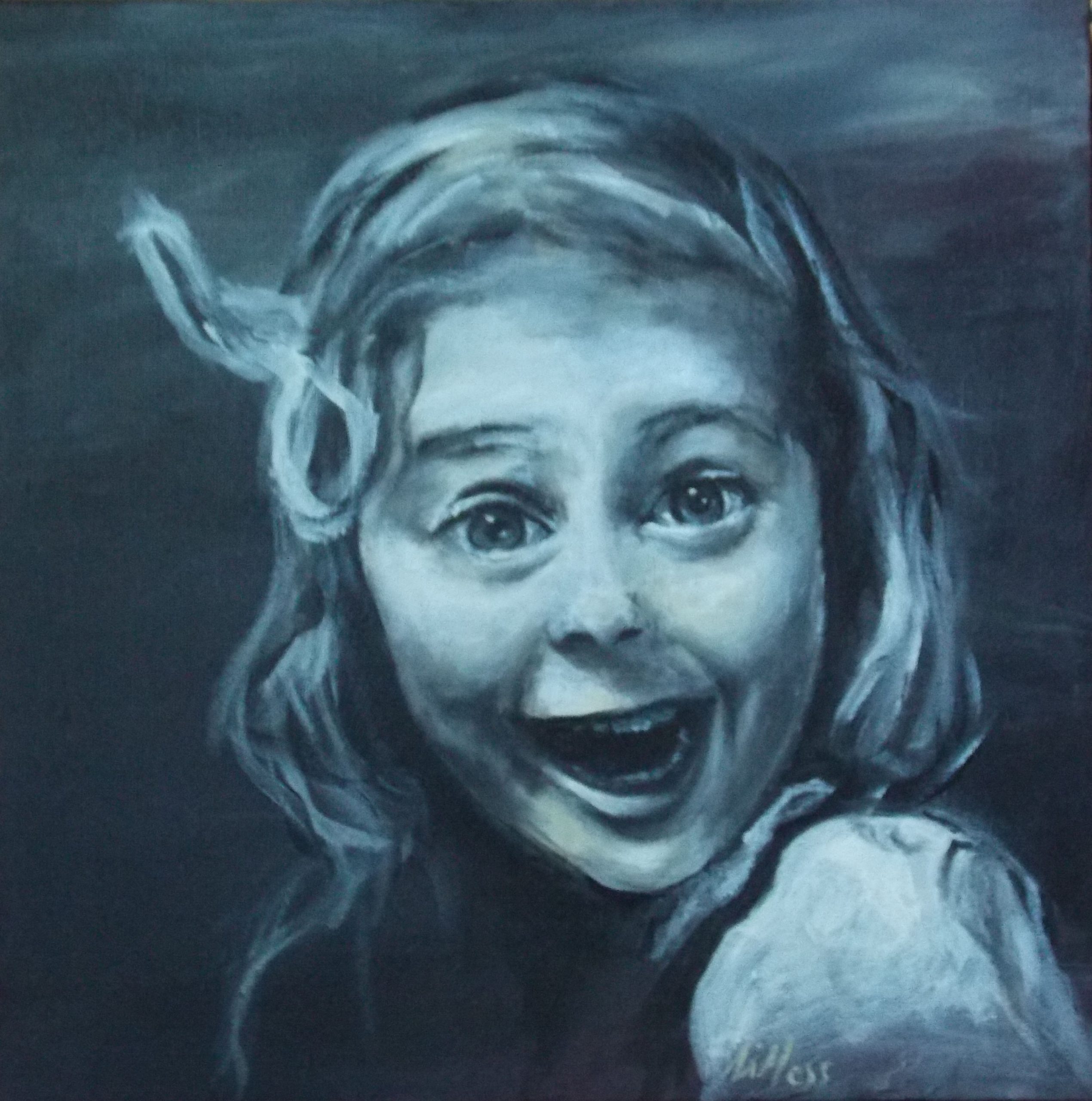
Jihane Mossalim
2nd year, Art Education Specialization
Tin Soldiers
acrylic paint on canvas
24″ x 36″
2015
Jack
10″x 10″
acrylic paint on canvas
2015
Jill
12″ x 12″
oil paint on canvas
2015
For this series, “Strangers,” I am exploring life paths unfamiliar to me. I collect old black-and-white photographs, looking for private histories, secret pasts, private intimacies, unknown memories. From garage sales, antique shops and online stores like e-bay, I look for photographs that are lost, discarded or otherwise forgotten and use them as source material for painting. I love the fact that these faces are completely alien to me; I don’t know these people, yet I am witness to these fragments of their lives, captured on film by a family member, friend or professional photographer. As I respond and react to these faces, my painting feels like it can give them a renewed importance.
I like the photos I find of children, soldiers, group portraits… There is a threat of discipline and an implied obedience in these that feels a little scary. The kids’ images have a melancholic quality to them; and at the same time children are not always as innocent as we imagine—they have a dark side, not always portrayed. I like the structure on view in the soldier’s portraits, the aesthetic of their costume, the contained emotion. These old photographs hint at the fearful extremes of growing up in school or in the army. Reacting to the strangeness of these photographs, I blend images, crop for detail, decontextualize and modify through paint on canvas. In doing so, I hope to give a new relevance to these strangers’ faces.

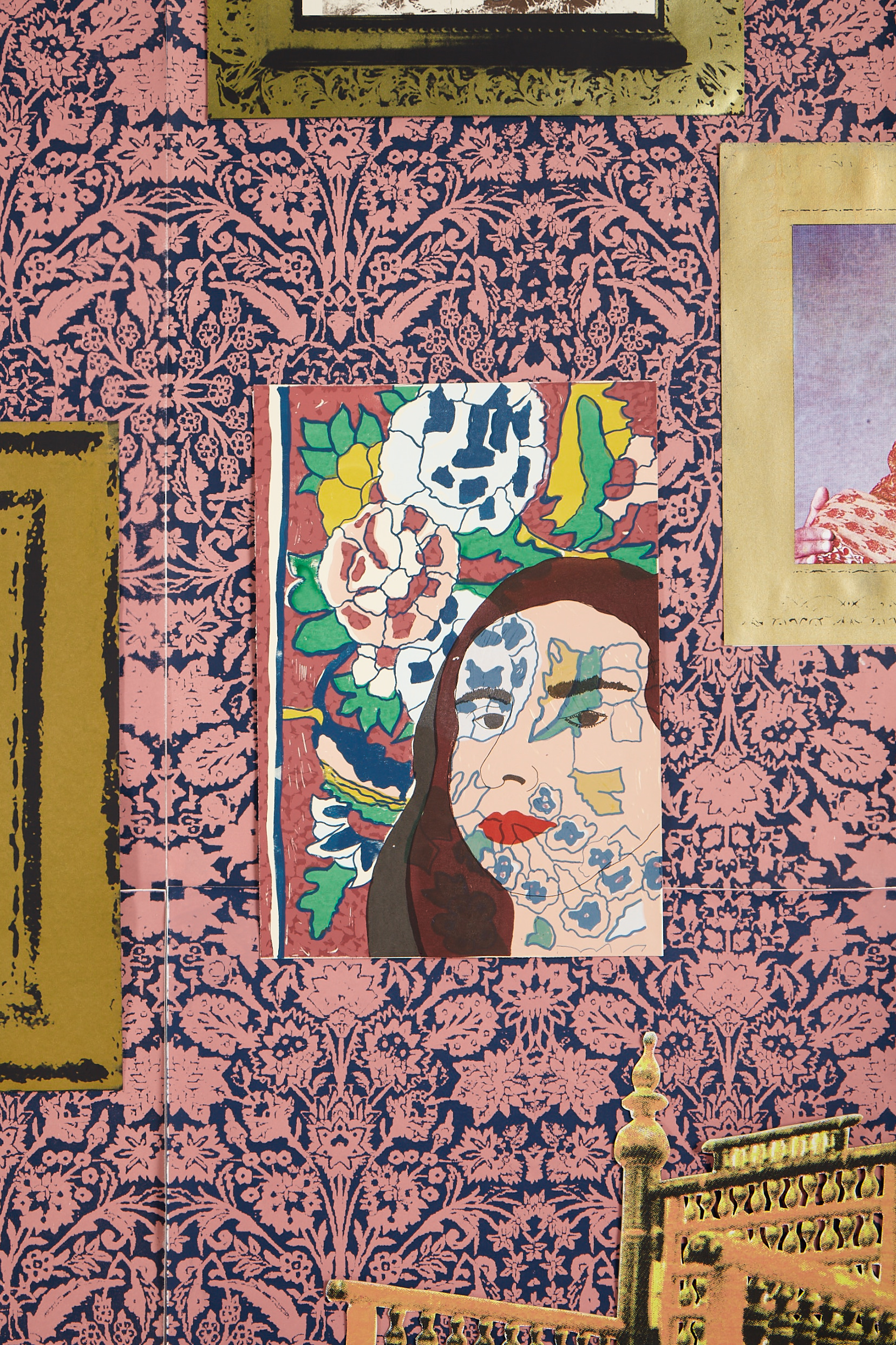
Shazia Ahmad
2nd year Painting and Drawing
Birthright – The Inheritance of a Legacy
110″ x 90″ x 0.1″
Installation, Screenprint and inkjet on paper
2017
Birthright- Inheritance of a Legacy weaves personal family history with a broader social commentary on young Pakistanis who have made a difference or given their lives trying to. Invoking the idea of home, combining objects of material culture, the works speaks to origins and the inheritance of history, be it personal or national. Born to a Pakistani father and Chilean mother and grew up in Pakistan, I have followed the news from a distance in recent years. Of particular importance to me in the last decade is how people trying to stimulate discussion, or simply live life, have become newsmakers. Controversy has dogged them on issues we take for granted in the developed world, namely the ability of girls to attend school (Malala Yousafzai); the use of social media for self-promotion yet highlighting societal hypocrisy (Qandeel Baloch); and advocacy for an open discussion on religion (Mashal Khan) and government policies (Sabeen Mahmud). Murder/attempted murder have not quelled the debates around these figures, and in some cases, justice eludes them. Creating an intimate space and combining personal archival black-and-white/sepia photos with the photos of these activists moves them beyond the realm of personality into personhood. Thus, they are members of my extended Pakistani family.
The project consists of 15 screen printed wallpaper panels (22 x30” each), tiled to create a space; the wallpaper is attached using poster putty. A combination of screen printed photos (5), illustrations (2), and inkjet-printed photos (3) are affixed on this wallpaper, along with the image of a traditional Sindhi chair. The photographs are displayed in screen printed picture frames.
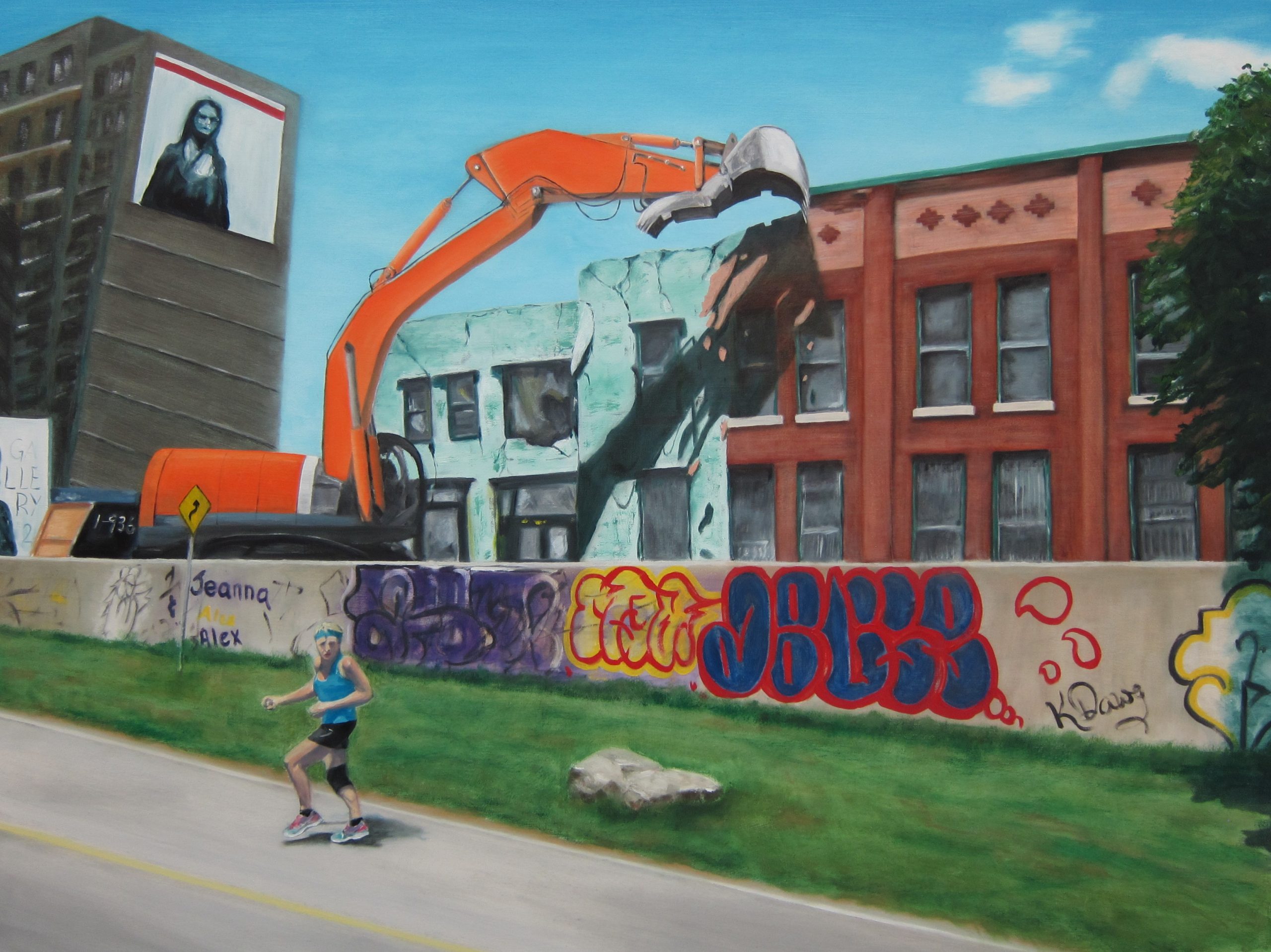

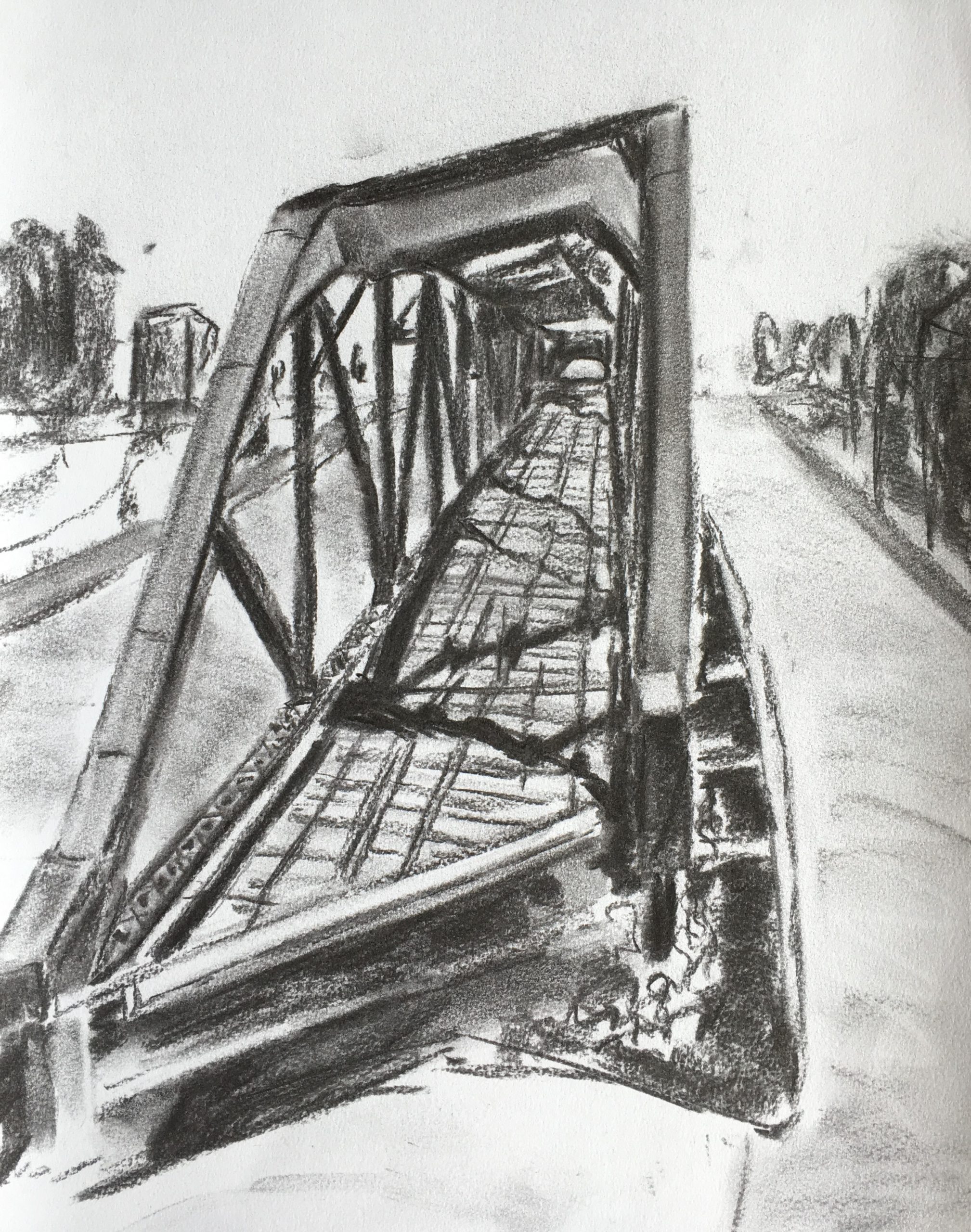
Kelly Rendek
2nd year, Painting and Drawing
Gallery 2 Be a Part of History
36 ” x 48″
Oil paint on canvas
2017
This painting is part of a larger project based on the Lachine Canal that I worked on during the summer of 2017. As I live close to the canal, I have a regular walking route that covers a loop from Lock #1 to the St-Gabriel lock. There is a lot of history along this route – the Lachine Canal is in fact a National Historic Site administered by Parks Canada – but also a lot of redevelopment. I began researching the history of the canal, and sketching the old buildings and bridges that line it. My route covers the area of Griffintown, once home to mostly Irish immigrants who built the canal and worked in the factories, and now a hotbed of new condominiums being developed for the modern era’s new “working class.” As I walk, I observe the many buildings along the canal that still reflect their original architecture, and I wonder about how we decide (or who decides) what should be preserved as “history” and what is okay to tear down.
One sunny morning on my regular route, I passed a new demolition site: one of these older buildings was in the process of being down for yet another condo expansion. The machines struck me as voracious creatures; the shadows they cast felt ominous. The marketing tagline for this condo development was “Be a Part of History,” and the irony hit me yet again. This painting attempts to capture my reaction to these events.